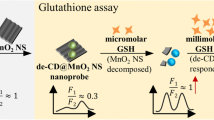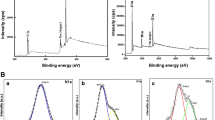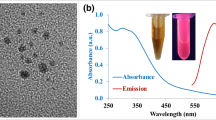Abstract
A sensitive and turn-on fluorescence nanoprobe based on core-shell Ag@Au nanoparticles (Ag@AuNPs) as a fluorescence receptor and red emissive graphene quantum dots (GQDs) as a donor was fabricated. They were conjugated together through π-π stacking between the GQDs and single-strand DNA modified at the Ag@AuNPs surface. The absorption spectrum of the receptor significantly overlapped with the donor emission spectrum, leading to a strong Förster resonance energy transfer (FRET) and thus a dramatic quenching. The sensing mechanism relies on fluorescence recovery following DNA cleavage by •OH produced from Fenton-like reaction between the peroxidase-like Ag nanocore and H2O2. The red emissive feature (Ex/Em, 520 nm/560 nm) provides low background in physiological samples. The •OH production, great spectrum overlapping, and red emission together contributes to good sensitivity and living cell imaging capability. The fluorescence assay (intensity at 560 nm) achieves a low detection limit of 0.49 μM H2O2 and a wide linear range from 5 to 200 μM, superior to most of the reported fluorescent probes. The RSD value for 100 μM H2O2 was 1.4%. The nanoprobe exhibits excellent anti-interferences and shows low cytotoxicity. The recovery of 100 μM standard H2O2 in a cancer cell lysate was 85.8%. Most satisfactorily, it can realize monitoring and imaging H2O2 in living cells. This study not only presents a sensitive H2O2 probe but also provides a platform for detecting other types of reactive oxygen species.
Graphical abstract






Similar content being viewed by others
References
Sun LF, Ding YY, Jiang YL, Liu QY (2017) Montmorillonite-loaded ceria nanocomposites with superior peroxidase-like activity for rapid colorimetric detection of H2O2. Sens Actuators B Chem 239:848–856. https://doi.org/10.1016/j.snb.2016.08.094
Lin MT, Beal MF (2006) Mitochondrial dysfunction and oxidative stress in neurodegenerative diseases. Nature 443:787–795. https://doi.org/10.1038/nature05292
Autreaux BD, Toledano MB (2007) ROS as signalling molecules: mechanisms that generate specificity in ROS homeostasis. Nat Rev Mol Cell Biol 8:813–824. https://doi.org/10.1038/nrm2256
Xi J, Xie C, Zhang Y, Wang L, Xiao J, Duan XM, Ren JH, Xiao F, Wang S (2016) Pd nanoparticles decorated N-doped graphene quantum dots@N-doped carbon hollow nanospheres with high electrochemical sensing performance in cancer detection. ACS Appl Mater Interfaces 8:22563–22573. https://doi.org/10.1021/acsami.6b05561
Sun J, Li CY, Qi YF, Guo SL, Xue L (2016) Optimizing colorimetric assay based on V2O5 nanozymes for sensitive detection of H2O2 and glucose. Sensors 16:584. https://doi.org/10.3390/s16040584
Wang Z, Ju P, Zhang Y, Jiang F, Din H, Sun C (2020) CoMoO4 nanobelts as efficient peroxidase mimics for the colorimetric determination of H2O2. Microchim Acta 187:424. https://doi.org/10.1007/s00604-020-04376-7
Liu J, Liang J, Wu C, Zhao YB (2019) A doubly-quenched fluorescent probe for low-background detection of mitochondrial H2O2. Anal Chem 91:6902–6909. https://doi.org/10.1021/acs.analchem.9b01294
Yuan J, Cen Y, Kong XJ, Wu S, Xia C (2015) MnO2-nanosheet-modified upconversion nanosystem for sensitive turn-on fluorescence detection of H2O2 and glucose in blood. ACS Appl Mater Interfaces 7:10548–10555. https://doi.org/10.1021/acsami.5b02188
Selvin PR (2000) The renaissance of fluorescence resonance energy transfer. Nat Struct Biol 7:730–734. https://doi.org/10.1038/78948
Liu SG, Mo S, Han L, Li N, Yu YZ, Li NB, Hong HQ (2019) Oxidation etching induced dual-signal response of carbon dots/silver nanoparticles system for ratiometric optical sensing of H2O2 and H2O2-related bioanalysis. Anal Chim Acta:81–1055, 89. https://doi.org/10.1016/j.aca.2018.12.015
Wang L, Zheng J, Li Y, Sheng Y, Liu C (2014) AgNP-DNA@GQDs hybrid: new approach for sensitive detection of H2O2 and glucose via simultaneous AgNP etching and DNA cleavage. Anal Chem 86:12348–12354. https://doi.org/10.1021/ac503653c
He W, Zhou YT, Wamer WG, Boudreau MD, Yin JJ (2012) Mechanisms of the pH dependent generation of hydroxyl radicals and oxygen induced by Ag nanoparticles. Biomaterials 33:7547–7455. https://doi.org/10.1016/j.biomaterials.2012.06.076
Cui Y, Ren B, Yao JL, Gu RA, Tian ZQ (2006) Synthesis of AgcoreAushell bimetallic nanoparticles for immunoassay based on surface-enhanced Raman spectroscopy. J Phys Chem B 110:4002–4006. https://doi.org/10.1021/jp056203x
Li Y, He D, Tu J, Wang R, Zu C, Chen Y, Yang W, Shi D, Thomas J, Shen Y (2018) The comparative effect of wrapping solid gold nanoparticles and hollow gold nanoparticles with doxorubicin-loaded thermosensitive liposomes for cancer thermo-chemotherapy. Nanoscale 10:8628–8641. https://doi.org/10.1039/C7NR09083H
Bhunia SK, Zeiri L, Manna J, Nandi S, Jelinek (2016) Carbon-dot/silver-nanoparticle flexible SERS-active films. ACS Appl Mater Interfaces 8:25637–25643. https://doi.org/10.1021/acsami.6b10945
Baker SN, Baker GA (2010) Luminescent carbon nanodots: emergent nanolights. Angew Chem Int Edit 49:6726–6744. https://doi.org/10.1002/anie.200906623
Liu JW, Luo Y, Wang YM, Duan LY, Jiang JH, Yu RQ (2016) Graphitic carbon nitride nanosheets-based ratiometric fluorescent probe for highly sensitive detection of H2O2 and glucose. ACS Appl Mater Interfaces 8:33439–33445. https://doi.org/10.1021/acsami.6b11207
Han M, Wang L, Li S, Liang B, Zhou Y (2017) High-bright fluorescent carbon dot as versatile sensing platform. Talanta 174:265–273. https://doi.org/10.1016/j.talanta2017.05.067
Hamd-Ghadareh S, Hamah-Ameen BA, Salimi A, Fath F, Soleimani F (2019) Ratiometric enhanced fluorometric determination and imaging of intracellular microRNA-155 by using carbon dots, gold nanoparticles and rhodamine B for signal amplification. Microchim Acta 186:469. https://doi.org/10.1007/s00604-019-3446-1
Dong Y, Shao J, Chen C, Li H, Wang RX, Chi YW, Xiao XM, Chen GN (2012) Blue luminescent graphene quantum dots and graphene oxide prepared by tuning the carbonization degree of citric acid. Carbon 50:4738–4743. https://doi.org/10.1016/j.carbon.2012.06.002
Zhou Z, Zhao L, Wang Z, Xue W, Wang Y, Huang Y, Liang J, Chen J, Li G (2018) Colorimetric detection of 1,5-anhydroglucitol based on graphene quantum dots and enzyme-catalyzed reaction. Int J Biol Macromol 112:1217–1224. https://doi.org/10.1016/j.ijbiomac.2018.02.093
Kuo SY, Li HH, Wu PJ, Chen CP, Huang YC, Chan YH (2015) Dual colorimetric and fluorescent sensor based on semiconducting polymer dots for ratiometric detection of lead ions in living cells. Anal Chem 87:4765–4771. https://doi.org/10.1021/ac504845t
Miao X, Qu D, Yang D, Nie B, Zhao YK, Fan HY, Sun ZC (2018) Synthesis of carbon dots with multiple color emission by controlled graphitization and surface functionalization. Adv Mater 30:1704740. https://doi.org/10.1002/adma.201870002
Rejman J, Oberle V, Zuhorn IS, Hoekstra D (2004) Size-dependent internalization of particles via the pathways of clathrin- and caveolae-mediated endocytosis. Biochem J 377:159–169. https://doi.org/10.1042/BJ20031253
Pelossof G, Tel-Vered R, Liu XQ, Willner I (2011) Amplified surface plasmon resonance based DNA biosensors, aptasensors, and Hg2+ sensors using hemin/G-quadruplexes and Au nanoparticles. Chem Eur J 17:8904–8912. https://doi.org/10.1002/chem.201100601
Zong LP, Ruan LY, Li JJ, Robert SM, Wang JS, Cosnier S, Zhang XJ, Shan D (2021) Fe-MOGs-based enzyme mimetic and its mediated electrochemiluminescence for in situ detection of H2O2 released from Hela cells. Biosens Bioelectron 184:113216. https://doi.org/10.1016/j.bios.2021.113216
Mao X, Liu S, Su B, Wang D, Huang Z, Li J, Zhang Y (2020) Luminescent europium(III)-organic framework for visual and on-site detection of hydrogen peroxide via a tablet computer. Microchim Acta 187:416. https://doi.org/10.1007/s00604-020-04379-4
Li N, Liu SG, Dong JX, Fan YZ, Ju YJ, Luo HQ, Li NB (2018) Using high-energy phosphate as energy-donor and nucleus growth-inhibitor to prepare carbon dots for hydrogen peroxide related biosensing. Sens Actuators B Chem 262:780–788. https://doi.org/10.1016/j.snb.2018.02.051
Mao Z, Qing Z, Qing T, Xu F, Wen L, He X, He D, Shi H (2015) Poly(thymine)-templated copper nanoparticles as a fluorescent indicator for hydrogen peroxide and oxidase-based biosensing. Anal Chem 87:7454–7460. https://doi.org/10.1021/acs.analchem.5b01700
Yadav PK, Singh VK, Chandra S, Bano D, Kuma V, Talat M, Hasan SH (2018) Green synthesis of fluorescent carbon quantum dots from Azadirachta indica leaves and their peroxidase-mimetic activity for the detection of H2O2 and ascorbic acid in common fresh fruits. ACS Biomater Sci Eng 5:5623–5632. https://doi.org/10.1021/acsbiomaterials.8b01528
Cairns RA, Harris IS, Mak TW (2011) Regulation of cancer cell metabolism. Nat Rev Cancer 11:85–95. https://doi.org/10.1038/nrc2981
Trachootham D, Alexandre J, Huang P (2009) Targeting cancer cells by ROS-mediated mechanisms: a radical therapeutic approach? Nat Rev Drug Discov 8:579–591. https://doi.org/10.1038/nrd2803
Funding
This work was financially supported by the National Natural Science Foundation of China (NSFC 21345007), the Plan for Scientific Innovation Talent of Henan Province to H. F. Cui (Grant number 154200510007), the Natural Science Foundation of Henan Province (Grant number 182300410314), the Henan Open-up and Collaboration Program of Science and Technology (Grant number 132106000070), and the Henan Key Project of Science and Technology (202102310346).
Author information
Authors and Affiliations
Corresponding author
Ethics declarations
Conflict of interest
The authors declare no competing interests.
Additional information
Publisher’s note
Springer Nature remains neutral with regard to jurisdictional claims in published maps and institutional affiliations.
This article is part of the Topical Collection on Nanomaterials for biomedical imaging and targeting
Supplementary information
ESM 1
(DOCX 1158 kb)
Rights and permissions
About this article
Cite this article
Shang, LL., Song, X., Niu, CB. et al. Red fluorescent nanoprobe based on Ag@Au nanoparticles and graphene quantum dots for H2O2 determination and living cell imaging. Microchim Acta 188, 291 (2021). https://doi.org/10.1007/s00604-021-04940-9
Received:
Accepted:
Published:
DOI: https://doi.org/10.1007/s00604-021-04940-9




